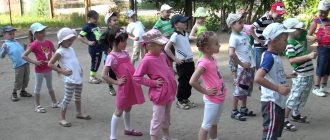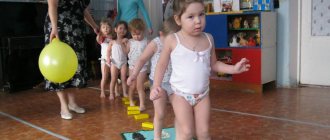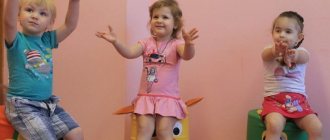Conducting morning exercises in the first junior group of kindergarten
When compiling a set of morning exercises, the teacher is guided, first of all, by ensuring that children have the opportunity to develop comprehensively, that is, different types of movements are selected. In addition, all the characters' lines, if any are implied by a specific type of gymnastics, are illustrated with movements.
It is advisable to include a variety of exercises in one gymnastics complex.
Table: card index of morning exercise complexes in the first junior group
| Name of the complex | Progress of the exercise | Accompanying words |
| "Watch" |
| “Show me how the clock goes. Tick-tock, tick-tock." |
| “The clock is ringing - bom-bom-bom.” | |
| “The watch is broken, we need to fix it with a special hammer.” | |
| Repeat the first exercise. | “So our watch started working again - tick-tock, tick-tock.” | |
| “Now we need to hang the clock higher on the wall.” | |
| “Now let’s show how quickly time flies.” | |
| "Turnip" | They go one after another. | “One grandfather and his wife and grandmother had a vegetable garden.” |
| They move on the outside of the foot. | “Once my grandfather went to plant turnips.” | |
| They jump forward, raising their arms. | “The weather is just fine, sunny, the birds are singing.” | |
| They walk on their toes, swinging their arms. | “Suddenly it started to rain.” | |
| They run with their hands clasped above their heads in a “house”. | “Grandfather ran home.” | |
| “Grandfather was going to plant a turnip, but he couldn’t find a shovel.” | |
| “The turnip became big, simply huge. Grandfather wanted to get it out of the ground, but he couldn’t.” | |
| “The grandfather began to call for helpers: grandmother, granddaughter, dog Zhuchka, cat Murka and, finally, mouse.” | |
| “So we pulled out a turnip!” | |
| “They all went home, ate, and then the helpers ran to their homes.” | |
| "Let's rattle the rattle" |
| "Let's rattle some rattles." |
| “Now let’s get the rattles.” | |
| Calm walking. | ||
Practicing a set of morning exercises is organized in 3 stages.
Table: timing of stages of morning exercises
| Stage | Goals | Types of exercises | Time |
| Introductory |
|
| 1–2 minutes |
| Basic |
|
| 2–3 minutes |
| Final | Restoring blood pressure and pulse. |
| 0.5–1 minute |
This is interesting. One complex can use 2-3 types of exercises from each stage.
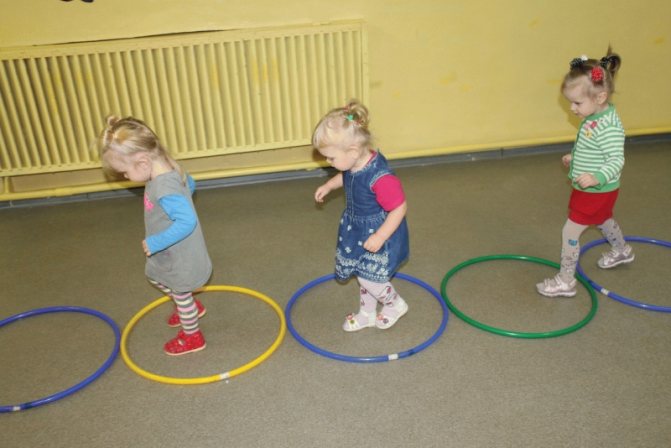
When allocating time for each stage, you need to make allowances for the pace at which children perform the exercises.
Table: example of a summary of morning exercises in the first junior group (fragment)
| Author | Aleshina M., teacher of MBDOU D/s No. 42 “Solnyshko”, Zavolzhye, Nizhny Novgorod region. |
| Introductory stage | The teacher brings a bear cub into the group. Reads a quatrain, addressing the children:
The little bear invites the children to play with him.
|
| Main part | <… “Big bear, small bear cub.” Starting position (IP): Standing, arms down along the body. V.: We understand the hands, we will show how big Mishka is. That's what it is! We give up. This is Mishka's little teddy bear. We do it 3 times. "The bear is dancing." I. p.: Standing, arms down along the body. V.: Let’s show how Mishka dances. He leaned one way and the other, that’s how cheerful Mishka is. Do it 3 times...> |
| The final stage | <… The little bear invites the guys to walk in a circle:
Mishka praises the children:
|
| Quote from: https://www.maam.ru/detskijsad/provedenie-utrenei-gimnastiki-v-pervoi-mladshei-grupe-gimnastika-s-mishkoi.html | |
Video: morning exercises in the first junior group with a doll character
Analysis of morning exercises in the first junior group of preschool educational institutions
Any type of activity in a preschool educational institution is subject to systematic monitoring (diagnosis), which allows not only to see progress in children’s development, but also to evaluate the effectiveness of the methods used by the teacher in their work. Analysis of morning exercises can be carried out in two formats:
- methodologists and teachers (usually morning exercises are assessed as one of the elements of working with children to form a general impression of the teacher’s methodological competence);
- by the teacher himself (to assess the level of preparation of children and identify organizational or substantive shortcomings in the work).
In both cases, the diagnostic plan will be the same.
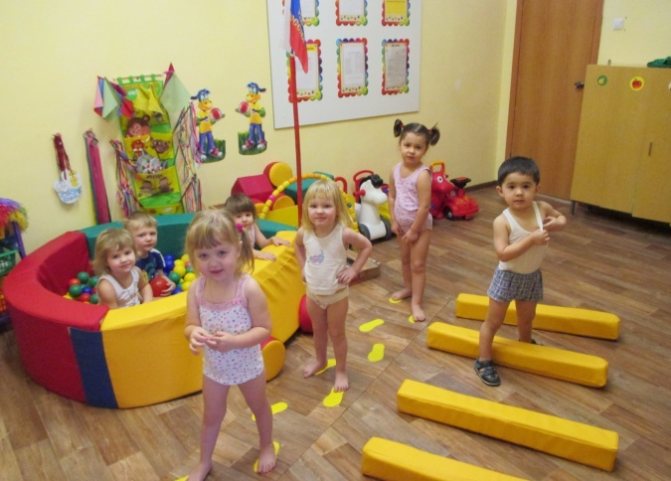
Analysis of morning exercises is one of the elements of general monitoring of the level of physical development of children
Scheme of analysis of morning exercises
The gymnastics analysis scheme includes the following evaluation criteria:
- General information about the group (name, total number of children and number of people present that day).
- Assessing the level of preparation for exercises (wet cleaning, ventilation).
- Appearance of the teacher (sportswear, tied up hair) and children (sports uniform, suitable shoes, girls' hair tied up).
- How long did the gymnastics last?
- Number of stages worked out (introductory, main and final).
- Description and timing of each stage, indicating the goals that were achieved or not achieved.
- Assessing the degree of teacher participation (explaining tasks, demonstrating movements).
- What emotional background was created.
- Overall assessment of the work (high, good, satisfactory).
Morning exercises in the first junior group are not only an important part of maintaining the daily routine, helping to improve health and provide conditions for the full physical development of children, but also a way to organize children for joint activities and foster a sense of camaraderie. Therefore, the teacher must approach the organization of gymnastics with special care. We must not forget that carrying out a set of exercises at the beginning of the day creates a positive emotional background in a group where most children have a hard time parting with their mothers in the morning.
Techniques for conducting morning exercises in the first junior group
Like any other activity, morning exercise requires careful selection of how you interact with your work. Traditionally, 4 types of techniques are used.
Verbal techniques
The speech of an adult is of enormous importance for the development of a child. Especially if this concerns children 1.5–3 years old who are just starting to speak. In order for speech development to occur harmoniously, you need to talk to preschoolers, illustrating any action with words.
Explanation
Morning exercises must be explained. At the same time, the teacher tries to select short sentences with understandable words, speak slowly, and clearly pronounce all the words.
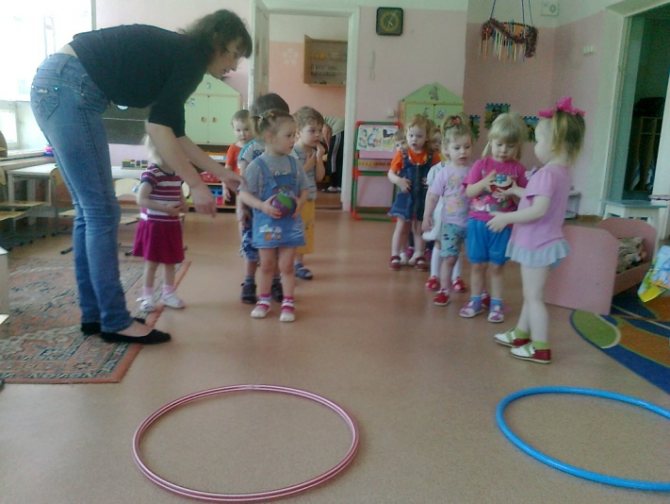
The teacher not only explains, but also shows all the actions
Puzzles
This verbal technique, which motivates children to work, requires from them not only a certain amount of knowledge, but also a vocabulary. Therefore, riddles begin to be played out in the second half of the year.
In my practice, I select riddles with rhyming agreements to make it easier for children to guess what is being said. For example, before performing a complex in the form of outdoor games, my children and I solve riddles in which the names of the exercises are encrypted:
- We returned at a late hour. Who greets us at the door? Who wags his tail with happiness and dances on his hind legs, licks his hands, licks his nose? This is our favorite... (Dog) - the game "Shaggy Dog".
- It can go and pour, There is water in the puddles. And not a hare, but a scythe, Sometimes it is torrential, In the fall it is a frequent visitor. Did you guess it? This is... (Rain) - the game "Rain".
- They scraped the bottom of the barrel, swept the barns. And through the forest, without roads, Rolled... (Kolobok) - the game “Kolobok is rolling.”
Poems
In my work, I also use this verbal technique to motivate students. Firstly, children enjoy listening to rhyming lines, and secondly, they quickly understand the essence of the topic. Thus, poems not only attract the attention of children, but also give them an idea of the tasks that will be in morning exercises. For example, if the kids and I are going to do the “Butterfly” story gymnastics, we start by listening to the poem of the same name:
- Amazing flower: Yellow, red patch! And along the edge there is lace. Oh! Head with a mustache! Here are the miracles: This is a beautiful butterfly! Summer beauty We all really like it!
Methodists also highlight sets of exercises that are performed to the accompaniment of poems (songs) that illustrate them - “gymnastics in verse.”
Table: examples of gymnastics in poetry (compiled based on open access materials)
| Title of the poem | Gymnastics move |
| "Matryoshka" | The nesting dolls gathered to play a little. They walked in circles and danced in a round dance. (Walking) Let's run after each other - (Running) These are funny girlfriends! They waved handkerchiefs, (Movements with their hands) They danced merrily, (Squats) They stomped their feet, (Movements according to the text) They clapped their hands. This is what kind of nesting dolls we are: (Tilts) We have red boots, Colorful handkerchiefs, (Blow on handkerchiefs) Satin ribbons. (Breathing exercise). |
| "Winter" | Children, line up in order for a fun exercise. To stretch our legs, we will walk along the path. And the path is not easy, It carries us along. (Walking) It’s frosty outside. To keep your nose from freezing, you need to stomp your feet (Stomp) and clap your palms. (Clap) Along the path, along the path We gallop on our right leg. And along the same path we gallop on our left leg. (They jump) We'll all go skiing, we'll climb the hill. Sticks will help us walk, The road will be easy for us. (They walk with long strides) And there are snowdrifts all around, the roads are covered with snow. Don’t get stuck in the field so that we raise our legs higher. (Hands on the belt, raise the knees) Let's run along the path, Let's run to the lawn. White flakes are flying, It has become colder. Only, winter-winter, you didn’t scare the guys. (Running) Snowflakes are falling from the sky, Like in a fairy-tale picture. We'll catch them with our hands and show them at home to mom. (Walking, clapping hands above your head) On the fluffy snow We started a game. You are a snowball and I am a snowball, stand in a circle, my friend. |
| "Palms" | Show me your palms and clap a little: Clap-clap-clap, Clap-clap-clap. Now look at me, (Make any movement) Repeat everything exactly. One-two-three, one-two-three. Now let’s show our legs and stomp a little. Top-top-top, Top-top-top. Show me your arms and legs, play with them a little. (Random movements of arms and legs) One-two-three, one-two-three. |
Video: morning exercises in the first junior group to a song
Short stories
I come up with such stories on the topic myself. From time to time, children need to be reminded of the importance of doing gymnastics, so one of the fairy tales could be like this: “Once upon a time there were two little men - Hilyachok and Fatty. One kept being capricious and didn’t want to eat anything, and the other did nothing but chew and never went far from home. One day they were sitting in the yard, and suddenly they saw a mischievous boy coming - Big Guy. They began to ask him why he was so happy and happy. And the big guy told them that he loves physical education, does morning exercises, eats cereals, vegetables and fruits. Then Hilyachok and Fatty began to take care of their health, doing physical exercise every morning and eating right. And within a month they became cheerful and joyful boys.”
When inventing fairy tales, you need to consider that:
- they should not be too long, otherwise children will be distracted from gymnastics;
- character names should be memorable;
- If possible, you need to select pictures to match the plot.
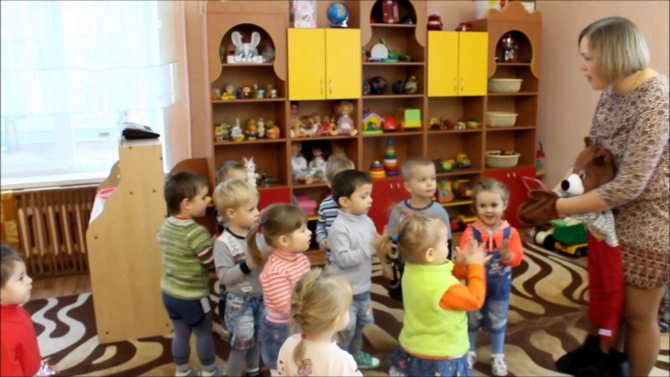
Fairy tales can be told from the perspective of a character who performs gymnastics
Visual techniques
Preschoolers perceive the world primarily through images. Therefore, visibility should accompany any type of activity of children. And morning exercises are no exception.
When working with my students I use:
- pictures depicting exercise characters - cats, dogs, bear cubs, etc.;
- illustrations of the order in which all elements of gymnastics are performed (for example, children running, jumping or the progress of work on the exercise “The bun is rolling”);
- demonstration (for the first younger group this is a demonstration of all the movements by the teacher or watching a video where gymnastics is performed by children’s peers).
Practical techniques
These types of work include types of creative activity:
- drawings;
- crafts;
- applications.
These techniques in the first junior group are reflective in nature: this is how children show their impressions of gymnastics. For example, after completing the “Let’s Rattle a Rattle” set of story-based gymnastics, the guys and I make an applique from blank rattles for the Tanyushka doll.
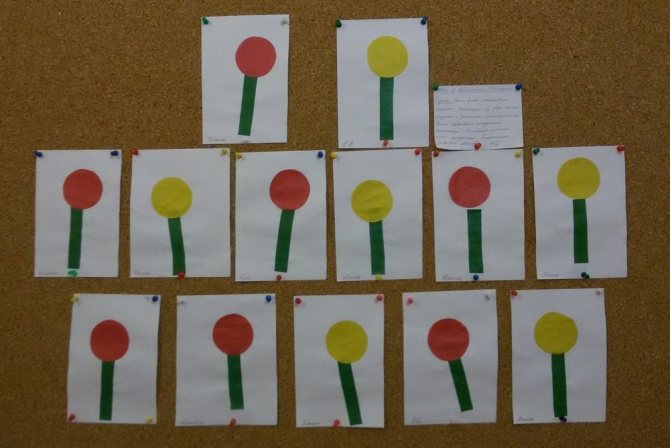
Performing applications, in addition to developing creative abilities, helps children remember the exercises
Gaming techniques
Play, as the main activity of preschoolers, provides a kind of framework for working on physical exercises. In morning exercises, outdoor games with theatrical elements are actively used.
Table: card index of outdoor games for morning exercises (compiled based on open access materials)
| Skill to be practiced | Name of the game | Tasks | Progress of the game |
| Run | “Sun and Rain” (“Rain”, “Sunny Bunnies”) |
| Children squat down behind the line designated by the teacher. The teacher says: “The sun is in the sky! You can go for a walk." Children are running around the playground. To the signal “Rain! Hurry home! run behind the marked line and squat down. The teacher says again: “Sunny! Go for a walk." The game repeats itself. |
| "Run to me" |
| Children stand on one side of the hall, so as not to disturb each other. The teacher stands on the opposite side. He says: “Run to me, everyone, everyone, run to me!” The children run to the teacher, who greets them warmly, spreading his arms wide to the sides, and pretends that he wants to hug all the children. After the children gather around the teacher, he goes to the other side of the playground and again says: “Run to me!” Before the start of the game, the teacher reminds that you can run only after the words “Run to me!”, You cannot push and interfere with each other. | |
| Orientation in space | "Shaggy Dog" |
| Children stand on one side of the playground. One child on the opposite side portrays a “dog”. The children quietly approach him, and the teacher at this time says:
Children approach the "dog". As soon as the teacher finishes reading the poem, the “dog” jumps up and “barks” loudly. The children run away, the “dog” tries to catch someone. When all the children hide, the “dog” returns to its place. |
| Development of balance | "Carousels" |
| The teacher invites the children to ride the carousel. Holds a hoop in his hands (being in the middle of the hoop) with multi-colored ribbons tied to it. Children take hold of the ribbons, the teacher moves with the hoop. Children walk and then run in a circle. The teacher says:
The children stop. |
| Strengthening the muscles of the trunk, spine, arch of the foot | "Kolobok is rolling" |
| Children pretend to be koloboks: they lie down on the carpet, straighten their legs and arms, and roll first in one direction, then in the other. At first, the adult helps the child, as if turning him over, saying: “Here comes Kolobok.” Rolling, rolling, can’t catch up with him.” Then the children roll themselves. |
| Formation of imitation skills | "Bubble" |
| Children and an adult stand in a circle. The teacher says:
Children, gradually moving back, expand the circle. When they hear the words “The bubble burst,” children lower their hands and pronounce the sound “sh-sh-sh.” |
| Agility development | "Frogs" |
| On one side of the hall there is a cord on the floor - this is a “swamp”. The “frog” children stand on the other side of the hall in one line on the starting line. The teacher says: “Here are the frogs jumping along the path with their legs outstretched, qua-kwa, kwa-kwa-kwa, jumping with their legs outstretched.” Children perform jumps on two legs in accordance with the rhythm of the poem, moving forward (about 16 jumps) to the “swamp”, and jump over the cord, saying: “Plop!” After a pause, the game exercise is repeated. |
| Formation of climbing skill | "Monkeys" | Exercise children in climbing a gymnastic wall. | The teacher invites the children, one or two at a time, to approach the gymnastics wall, stand facing it and climb 3-4 slats. These are monkeys. The rest of the children sit or stand and watch the monkeys pick fruit from the trees. Then other monkeys climb up the trees. |
| Development of attention | "Checkbox" | Teach children to stand in a circle and perform actions while singing along to a song | Children stand in a circle, in the middle of the circle there is a flag. The kids walk in a circle and say the text. The child comes out according to the text, picks up the flag, waves it and puts it back. Then the game continues.
|
This is interesting. Some morning complexes also include 1-2 exercises of finger games and/or breathing exercises.
